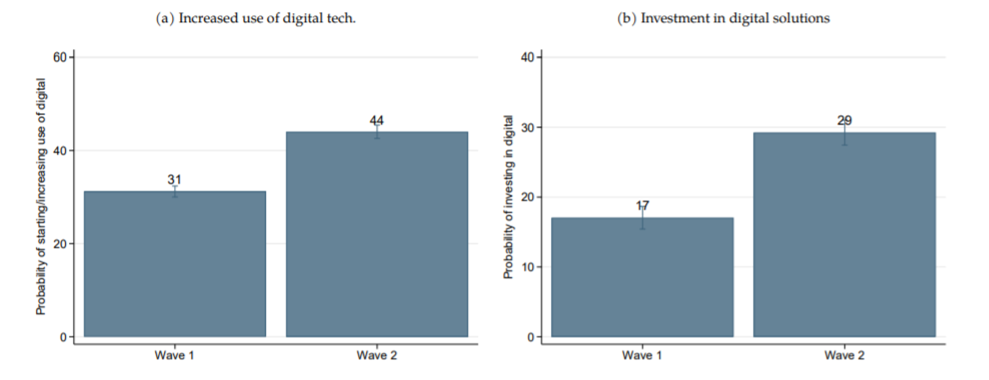 Close up of student hand writing a book with laptop at library vintage tone.
Close up of student hand writing a book with laptop at library vintage tone.
This blog is a biweekly feature highlighting recent working papers from around the World Bank Group that were published in the World Bank’s Policy Research Working Paper Series. This entry introduces seven papers published from October 16 to October 31 on various topics, including data and development, COVID-19, and gender.
First, to celebrate World Development Information Day and the recently launched WDR 2021: Data for Better Lives we present a paper that addresses the transformational impact that public sector data has on development outcomes. In Under What Conditions Are Data Valuable for Development, Dean Jolliffe and coauthors explore through case studies the 12 conditions needed for the production and use of public sector data to generate value for development. The conditions are that data need to have adequate spatial and temporal coverage (are complete, frequent and timely), are of high quality (are accurate, comparable and granular), are easy to use (are accessible, understandable and interoperable) and are safe to use (impartial, confidential and appropriate).
The next two papers we introduce analyze topics related to COVID-19. In The Impact of the COVID-19 Pandemic on Women-Led Businesses, Kathleen Beegle and coauthors examine the differential effect of the COVID-19 pandemic of women-led and men-led businesses. In Firm Recovery during COVID-19 : Six Stylized Facts, Xavier Cirera and coauthors present a new set of stylized facts on firm recovery, covering 65,000 observations in 38 countries.
- The Impact of the COVID-19 Pandemic on Women-Led Businesses examines a unique sample of close to 40,000 mainly formal businesses from 49 countries covering the months between April and September 2020. The findings show that women-led micro-businesses, women-led businesses in the hospitality industry, and women-led businesses in countries more severely affected by the COVID-19 shock were disproportionately hit compared with businesses led by men. At the same time, women-led micro-firms were markedly more likely to report increasing the use of digital platforms, but less likely to invest in software, equipment, or digital solutions. The findings also show that women-led businesses were less likely to have received some form of public support although they have been hit harder in some domains.
- Figure 1 shows the correlation between change in sales revenue and the measures of financial fragility, after controlling for a number of confounding factors. The left panel shows that while on average businesses that experienced larger sales drop tend to have more liquidity problems, businesses led by women report significantly less cash available when experiencing a similar shock to sales revenue. The right panel shows that experiencing larger drops in sales revenue is associated with a disproportionately higher likelihood of falling in arrears if the business is led by a woman. The difference between men-led and women-led businesses in both panels is statistically significant.
Figure 1: Correlation between financial risks and change in sales revenue
- Firm Recovery during COVID-19 : Six Stylized Facts suggests, among other facts, that since the outset of the pandemic, some aspects of business performance such as sales show signs of partial recovery while other aspects remain challenging, including persistently high uncertainty and financial fragility. It is also the case that the diffusion of digital technology and product innovation accelerated during the pandemic but did so unevenly, further widening gaps between small and large firms. Figure 2 shows how firms responded by accelerating the use of existing digital technologies, investing in new digital solutions and by altering their product-mix. This expansion in the use of digital technologies allowed firms to better reach consumers (or reach new ones) and organize production more flexibly and efficiently. Nearly 44% of businesses have increased the use of digital technologies, compared to 31% in the first wave (Figure 2 panel a). This shift towards the acceleration of digitization is confirmed in Figure 2 panel (b), showing that 29% of firms had invested in new digital solutions, nearly doubling from wave 1.
Figure 2: Probability of Digitization

The next three papers we introduce delve into topics related to gender, violence, and displacement. In Differences in Household Composition : Hidden Dimensions of Poverty and Displacement in Somalia, Lucia Hanmer and coauthors use a nationally representative survey to analyze poverty among internally displaced people and non-displaced people in Somalia to shed light on how gender inequality influences poverty rates of forcibly displaced people. In Conflict, Displacement and Overlapping Vulnerabilities : Understanding Risk Factors for Gender-Based Violence among Displaced Women in Eastern Democratic Republic of Congo, Jocelyn TD Kelly and coauthors analyze using a large randomized survey sexual violence and intimate partner violence as an outcome in the Eastern Democratic Republic of Congo. In the last of the gender themed papers Do Gender Norms Become Less Traditional with Displacement The Case of Colombia, Eliana Rubiano-Matulevich operationalizes a definition of gender norms that brings together the behaviors and attitudes of displaced and non-displaced women using household survey data for Colombia.
- Differences in Household Composition : Hidden Dimensions of Poverty and Displacement in Somalia shows that male-headed households are poorer than female-headed ones among both internally displaced and non-displaced groups. Demographic characteristics are strongly associated with poverty rates for internally displaced people but not for non-displaced people. Having more income earners reduces poverty risk for all households. For internally displaced people’s households, the largest decrease in poverty risk is associated with having more female earners, while having more male earners is associated with the lowest poverty for nondisplaced people’s households. The analysis highlights that poverty reduction policies and programs must cover all households and lift barriers to women’s economic opportunities.
- Conflict, Displacement and Overlapping Vulnerabilities : Understanding Risk Factors for Gender-Based Violence among Displaced Women in Eastern Democratic Republic of Congo, finds that displacement increases a woman’s risk of past-year intimate partner violence by 6 percent and experiencing war abuses increases the risk of lifetime intimate partner violence by 9 percent, after adjusting for other risk factors. Both exposure to war-related experiences and displacement independently increase the risk of past-year sexual violence by 6 percent, after adjusting for other risk factors. Forced displacement and traumatic war-related experiences are risk factors for intimate partner violence and sexual violence in this setting.
- Do Gender Norms Become Less Traditional with Displacement The Case of Colombia shows that gender norms condoning violence against women relax with displacement, while those that limit women’s economic opportunities become more rigid. The findings also reveal a misalignment between attitudes and behaviors in other domains. Displaced women have less rigid patriarchal attitudes, but their ability to decide about contraception and their own earnings decreases following displacement.
Finally, the last paper we introduce in this roundup is very timely as COP26 is taking place this week. In Understanding Drivers of Decoupling of Global Transport CO2 Emissions from Economic Growth : Evidence from 145 Countries, Vivien Foster and coauthors examine the extent to which countries have succeeded in decoupling transport emissions from economic growth, and how changes in emissions intensity, economic growth, and population growth have contributed to changes in transportation-related emissions. The results reveal that while transportation emission intensity has declined in most countries, economic growth and population growth have offset these declines. If these patterns continue, achieving the goals of the Paris Agreement with improvements in efficiency alone seems unrealistic. The paper also shows evidence that higher energy prices are associated with strong emissions reduction.
The following are other interesting papers published in the second half of October. Please make sure to read them as well.
- The Risk That Travels with You : Links between Forced Displacement, Conflict and Intimate Partner Violence in Colombia and Liberia (Kelly,Jocelyn TD,Rubin,Amalia Hadas,Ekhator-Mobayode,Uche Eseosa,Arango,Diana Jimena)
- How Do Gender Norms Shape Education and Domestic Work Outcomes The Case of Syrian Refugee Adolescents in Jordan (Krafft,Caroline Gould,Ragui,Assaad,Pastoor,Isabel)
- Multidimensional Poverty, Gender, and Forced Displacement : A Multi-Country, Intrahousehold Analysis in Sub-Saharan Africa (Admasu,Yeshwas,Alkire,Sabina,Scharlin-Pettee,Sophie)
- A Multi-Country Analysis of Multidimensional Poverty in Contexts of Forced Displacement (Admasu,Yeshwas,Alkire,Sabina,Ekhator-Mobayode,Uche Eseosa,Kovesdi,Fanni,Santamaria,Julieth,Scharlin-Pettee[,Sophie)
- The Double Burden of Female Protracted Displacement : Survey Evidence on Gendered Livelihoods in El Fasher, Darfur (Stojetz,Wolfgang,Brück,Tilman)
- Intimate Partner Violence and Household Decision Making Autonomy : Effects of the Malian Conflict on Women (Ekhator-Mobayode,Uche Eseosa,Kelly,Jocelyn Thalassa Deverall,Rubin,Amalia Hadas,Arango,Diana Jimena)
- Targeting for Social Safety Nets : Evidence from Nine Programs in the Sahel (Schnitzer,Pascale,Stoeffler,Quentin)
- Sectoral Value Added — Electricity Elasticities across Countries (Hovhannisyan,Shoghik,Stamm,Kersten Kevin)
- Integration in Global Value Chains — The Role of Service Inputs : Evidence from India (Manghnani,Ruchita,Meyer,Birgit Elisabeth,Saez,Juan Sebastian,Van Der Marel,Erik Leendert)
- The Impact of Corruption on SMEs’ Access to Finance : Evidence Using Firm-Level Survey Data from Developing Countries (Amin,Mohammad,Motta,Vctor)
- Firm Performance, Participation in Global Value Chains and Service Inputs : Evidence from India (Manghnani,Ruchita,Meyer,Birgit Elisabeth,Saez,Juan Sebastian,Van Der Marel,Erik Leendert)




Join the Conversation